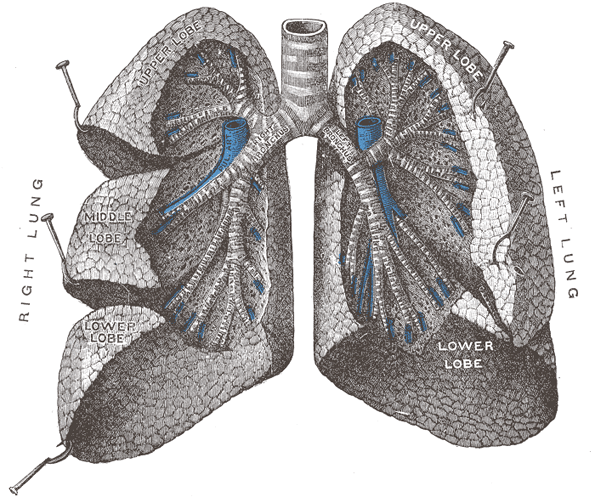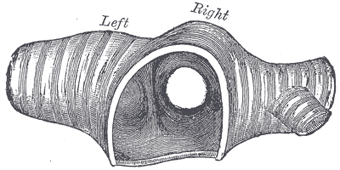 |
| FIG. 961– Front view of cartilages of larynx, trachea, and bronchi. |
|
| The trachea or windpipe (Fig. 961) is a cartilaginous and membranous tube, extending from the lower part of the larynx, on a level with the sixth cervical vertebra, to the upper border of the fifth thoracic vertebra, where it divides into the two bronchi, one for each lung. The trachea is nearly but not quite cylindrical, being flattened posteriorly; it measures about 11 cm. in length; its diameter, from side to side, is from 2 to 2.5 cm., being always greater in the male than in the female. In the child the trachea is smaller, more deeply placed, and more movable than in the adult. |
| |
| Relations.—The anterior surface of the trachea is convex, and covered, in the neck, from above downward, by the isthmus of the thyroid gland, the inferior thyroid veins, the arteria thyroidea ima (when that vessel exists), the Sternothyreoideus and Sternohyoideus muscles, the cervical fascia, and, more superficially, by the anastomosing branches between the anterior jugular veins; in the thorax, it is covered from before backward by the manubrium sterni, the remains of the thymus, the left innominate vein, the aortic arch, the innominate and left common carotid arteries, and the deep cardiac plexus. Posteriorly it is in contact with the esophagus. Laterally, in the neck, it is in relation with the common carotid arteries, the right and left lobes of the thyroid gland, the inferior thyroid arteries, and the recurrent nerves; in the thorax, it lies in the superior mediastinum, and is in relation on the right side with the pleura and right vagus, and near the root of the neck with the innominate artery; on its left side are the left recurrent nerve, the aortic arch, and the left common carotid and subclavian arteries. |
| The Right Bronchus (bronchus dexter), wider, shorter, and more vertical in direction than the left, is about 2.5 cm. long, and enters the right lung nearly opposite the fifth thoracic vertebra. The azygos vein arches over it from behind; and the right pulmonary artery lies at first below and then in front of it. About 2 cm. from its commencement it gives off a branch to the upper lobe of the right lung. This is termed the eparterial branch of the bronchus, because it arises above the right pulmonary artery. The bronchus now passes below the artery, and is known as the hyparterial branch; it divides into two branches for the middle and lower lobes. |
| |
| The Left Bronchus (bronchus sinister) is smaller in caliber but longer than the right, being nearly 5 cm. long. It enters the root of the left lung opposite the sixth thoracic vertebra. It passes beneath the aortic arch, crosses in front of the esophagus, the thoracic duct, and the descending aorta, and has the left pulmonary artery lying at first above, and then in front of it. The left bronchus has no eparterial branch, and therefore it has been supposed by some that there is no upper lobe to the left lung, but that the so-called upper lobe corresponds to the middle lobe of the right lung. |
| The further subdivisions of the bronchi will be considered with the anatomy of the lung. |
 |
| FIG. 962– Bronchi and bronchioles. The lungs have been widely separated and tissue cut away to expose the air-tubes. (Testut.) |
| |
| If a transverse section be made across the trachea a short distance above its point of bifurcation, and a bird’s-eye view taken of its interior (Fig. 963), the septum placed at the bottom of the trachea and separating the two bronchi will be seen to occupy the left of the median line, and the right bronchus appears to be a more direct continuation of the trachea than the left, so that any solid body dropping into the trachea would naturally be directed toward the right bronchus. This tendency is aided by the larger diameter of the right tube as compared with its fellow. This fact serves to explain why a foreign body in the trachea more frequently falls into the right bronchus. (*157 |
 |
| FIG. 963– Transverse section of the trachea, just above its bifurcation, with a bird’s-eye view of the interior. |
| |
| |
| Structure (Fig. 964).—The trachea and extrapulmonary bronchi are composed of imperfect rings of hyaline cartilage, fibrous tissue, muscular fibers, mucous membrane, and glands. |
| The cartilages of the trachea vary from sixteen to twenty in number: each forms an imperfect ring, which occupies the anterior two-thirds or so of the circumference of the trachea, being deficient behind, where the tube is completed by fibrous tissue and unstriped muscular fibers. The cartilages are placed horizontally above each other, separated by narrow intervals. They measure about 4 mm. in depth and 1 mm. in thickness. Their outer surfaces are flattened in a vertical direction, but the internal are convex, the cartilages being thicker in the middle than at the margins. Two or more of the cartilages often unite, partially or completely, and they are sometimes bifurcated at their extremities. They are highly elastic, but may become calcified in advanced life. In the right bronchus the cartilages vary in number from six to eight; in the left, from nine to twelve. They are shorter and narrower than those of the trachea, but have the same shape and arrangement. The peculiar tracheal cartilages are the first and the last (Fig. 961). |
| The first cartilage is broader than the rest, and often divided at one end; it is connected by the cricotracheal ligament with the lower border of the cricoid cartilage, with which, or with the succeeding cartilage, it is sometimes blended. |
| The last cartilage is thick and broad in the middle, in consequence of its lower border being prolonged into a triangular hook-shaped process, which curves downward and backward between the two bronchi. It ends on each side in an imperfect ring, which encloses the commencement of the bronchus. The cartilage above the last is somewhat broader than the others at its center. |
| |
| The Fibrous Membrane.—The cartilages are enclosed in an elastic fibrous membrane, which consists of two layers; one, the thicker, passing over the outer surface of the ring, the other over the inner surface: at the upper and lower margins of the cartilages the two layers blend together to form a single membrane, which connects the rings one with another. They are thus invested by the membrane. In the space behind, between the ends of the rings, the membrane forms a single layer. |
| The muscular tissue consists of two layers of non-striated muscle, longitudinal and transverse. The longitudinal fibers are external, and consist of a few scattered bundles. The transverse fibers (Trachealis muscle) are internal, and form a thin layer which extends transversely between the ends of the cartilages. |
| |
| Mucous Membrane.—The mucous membrane is continuous above with that of the larynx, and below with that of the bronchi. It consists of areolar and lymphoid tissue, and presents a well-marked basement membrane, supporting a stratified epithelium, the surface layer of which is columnar and ciliated, while the deeper layers are composed of oval or rounded cells. Beneath the basement membrane there is a distinct layer of longitudinal elastic fibers with a small amount of intervening areolar tissue. The submucous layer is composed of a loose mesh-work of connective tissue, containing large bloodvessels, nerves, and mucous glands; the ducts of the latter pierce the overlying layers and open on the surface (Fig. 964). |
 |
| FIG. 964– Transverse section of trachea. |
| |
| |
| Vessels and Nerves.—The trachea is supplied with blood by the inferior thyroid arteries. The veins end in the thyroid venous plexus. The nerves are derived from the vagus and the recurrent nerves, and from the sympathetic; they are distributed to the Trachealis muscles and between the epithelial cells. |




